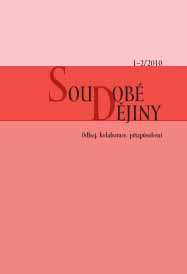(Ne)patřičné poznámky¸k jednomu německému bestselleru Alfred de Zayas o vyhnání Němců
(Un)suitable Remarks on a German Bestseller by Alfred de Zayas Concerning the Expulsion of the Sudeten Germans
Author(s): Hans-Henning Hahn, Eva HahnováSubject(s): History
Published by: AV ČR - Akademie věd České republiky - Ústav pro soudobé dějiny
Summary/Abstract: In this polemical essay the authors present the American lawyer and historian Alfred-Maurice de Zayas (born in Havana, in 1947), who has become one of the most successful authors of German literature on the expulsion of the Czechoslovak Germans (Vertreibungsliteratur). They also discuss his Nemesis at Potsdam: The Anglo-Americans and the Expulsion of the Germans, which has been published in six English editions and at least ten German (first by Routledge & Kegan Paul, in London and Boston, in 1977, most recently in a revised and expanded edition by Herbig, Munich – Die Nemesis von Potsdam: Die Anglo-Amerikaner und die Vertreibung der Deutschen). The book considers how eleven million Germans living east of the post-war German frontier lost their homeland between 1939 and 1949. According to the authors of the essay, the book, with its notes and bibliography, meets the criteria of professional historiography in terms of form, but it is not actually conceived as empirical research on events and developments. Rather it is more like discovery proceedings for an indictment of the Allied forces, who, de Zayas alleges, were seeking revenge against Germans, rather than justice. In terms of content, the book contains nothing new, more or less reproducing the historical stereotypes of the Germans, Czechs, and Poles, and their relations with each other, in the way these have been transmitted mainly in German ‘expulsion historiography’ and journalism. Thus, for example, the Munich Agreement of September 1938 is seen as the logical outcome of the unjust arrangement of central Europe after the Great War; the German minorities’ irredentist ambitions in the successor states are called a reaction to discrimination; and the Sudeten Germans are depicted as the innocent victims of Hitler’s policy. These one-sided pictures of the past, which de Zayas presents, are intended, according to the reviewers, mainly to justify current political aims – namely, reparation for the ‘expellees’ from the formerly German eastern territories in keeping with international law in the form of ‘Recht auf Heimat’ (that is, the right to return to the homeland), restitution of property, and compensation for damages. De Zayas, however, completely ignores the fact that such arguments have not been accepted by any court of law. His success amongst readers reveals, according to the reviewers, that his interpretations continue to suit considerable parts of German society, which prefer the ‘myth of expulsion’ to a critical view of the recent past.
Journal: Soudobé Dějiny
- Issue Year: XVII/2010
- Issue No: 01-02
- Page Range: 158-172
- Page Count: 15
- Language: Czech

